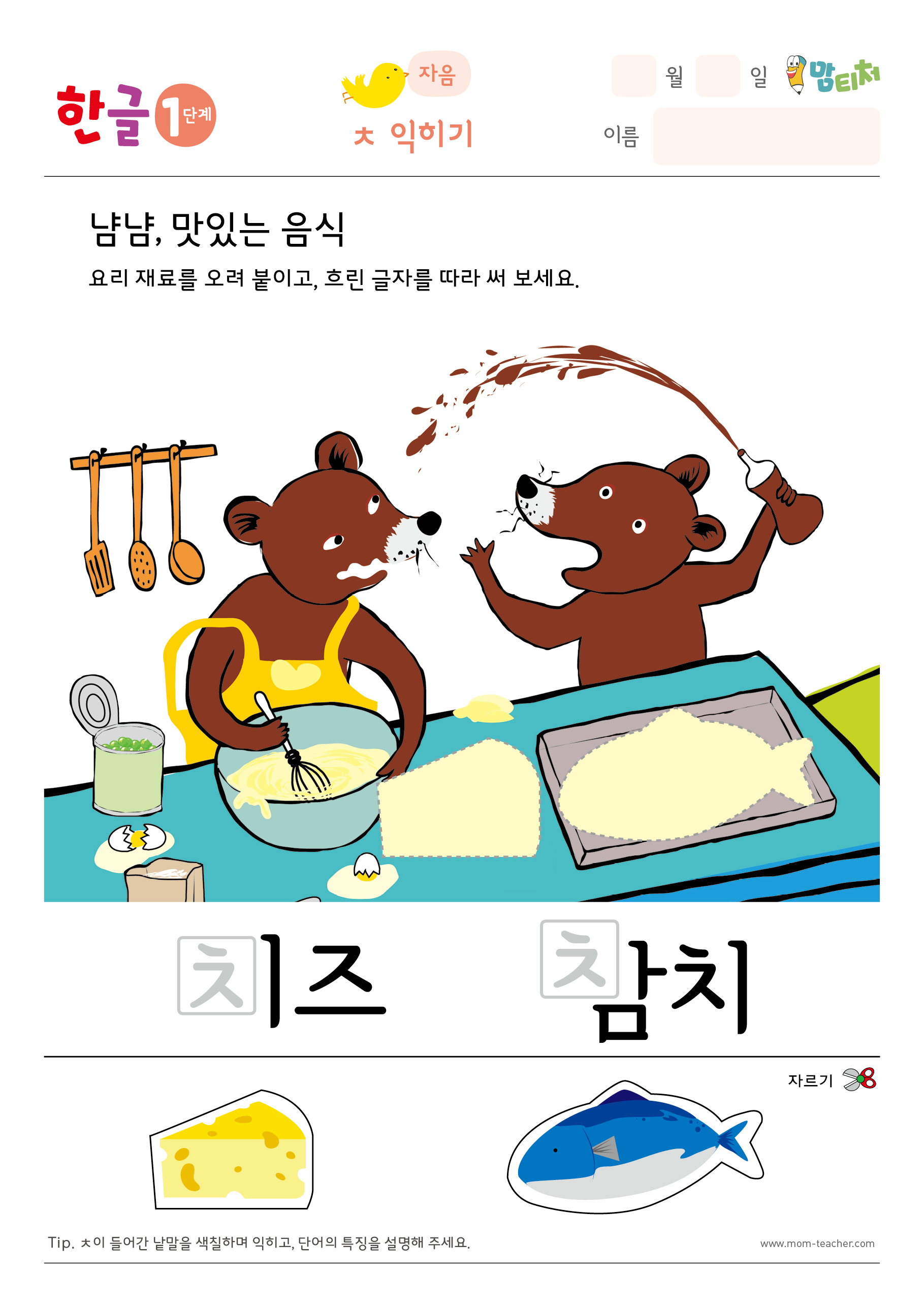냠냠 영어로
냠냠 영어로 얘기하는 이유는 무엇일까요? 냠냠 영어로 먹는다는 것은 영어로 음식에 대해 이야기하고 나누는 것을 의미합니다. 이러한 유명한 어구는 한국어로 맛있게 먹는다는 냠냠 소리와 영어를 합해 만들어진 표현입니다. 냠냠 영어로 먹는다는 것은 먹는 행위 자체를 영어로 표현함으로써 영어 실력의 향상과 재미있는 경험을 동시에 얻을 수 있는 활동입니다.
냠냠 영어로 먹는다는 것의 의미는 무엇일까요? 이 표현의 의미는 정확한 번역이 아닌, 음식에 대한 즐거움과 만족을 영어로 표현한다는 느낌입니다. 뭐라 먹고 싶다고 할 때 “Yummy”, “Yum Yum”, “야미 영어로” 등의 표현을 사용하여 음식에 대한 맛있는 경험을 나눌 수 있습니다. 이를 통해 음식에 대한 즐거움을 영어로 표현하는 것은 다른 사람들과의 소통을 위해 중요한 요소이기도 합니다.
영어로 음식을 먹는 것은 어떤 장점을 갖고 있을까요? 냠냠 영어로 음식을 먹는 것은 영어 실력 향상에 많은 도움이 될 수 있습니다. 실제로 음식은 우리의 일상에서 매우 중요한 부분이기 때문에 영어로 음식에 대해 이야기하기 위해서는 다양한 어휘와 문법을 사용해야 합니다. 이를 통해 영어 실력을 향상시킬 수 있으며, 영어를 자유롭게 사용하고 표현할 수 있는 능력을 키울 수 있습니다.
냠냠 영어로 음식을 먹는 것은 영어 실력 향상에 어떤 도움이 될까요? 냠냠 영어로 음식을 먹는 것은 영어 쓰기와 말하기 능력을 향상시키는 데 도움을 줄 수 있습니다. 음식을 영어로 설명하고 논의하는 과정은 새로운 어휘와 표현을 익히는 기회를 제공합니다. 이를 통해 영어 실력을 다양한 상황에서 활용할 수 있는 범위를 넓히고, 자신의 의견을 구체적으로 표현하는 능력을 향상시킬 수 있습니다.
냠냠 영어로 음식을 먹는 것이 문화 교류에 어떤 기여를 할 수 있을까요? 음식은 문화적인 차원에서 매우 중요한 요소입니다. 다양한 나라의 음식에 대해 이야기하고 나누는 것은 서로의 문화를 이해하고 존중하는 데 도움이 됩니다. 냠냠 영어로 음식을 먹는 것은 서로 다른 문화 간의 소통을 촉진시키는 역할을 할 수 있으며, 다른 나라의 음식을 소개함으로써 문화 교류를 이끌어낼 수 있습니다.
어떻게 냠냠 영어로 음식을 먹을 수 있을까요? 음식을 먹는 과정 속에서 영어를 사용하는 방법은 다양합니다. 음식을 섭취하면서 영어로 설명하거나, 맛을 표현하는 단어와 표현을 사용할 수 있습니다. 또한 음식과 관련된 영어 단어를 알아보고, 다른 사람들과 함께 음식에 대해 토론하고 나누는 것도 좋은 방법입니다. 냠냠 영어로 음식을 먹는 것은 단순한 행위가 아니라, 새로운 경험을 얻을 수 있는 방법입니다.
냠냠 영어로 음식 관련 자료와 리소스를 어디서 찾을 수 있을까요? 영어로 음식에 대한 자료와 리소스는 인터넷을 통해 쉽게 찾을 수 있습니다. 식당 리뷰 사이트나 요리 블로그, 유튜브 채널 등은 많은 영어로 된 음식 관련 자료를 제공합니다. 또한 영어 어플이나 온라인 커뮤니티에서도 음식에 관한 영어 자료를 찾을 수 있습니다. 이러한 자료와 리소스를 활용하여 냠냠 영어로 음식에 대한 지식을 쌓고 실력을 향상시킬 수 있습니다.
냠냠 영어로 음식을 먹는 것에 대한 경험담을 소개해볼까요? 한 사용자는 냠냠 영어로 음식을 먹는 것을 통해 새로운 맛과 즐거움을 경험했습니다. 그는 다양한 나라의 음식을 영어로 설명하고 소개하면서 새로운 음식을 발견하고 맛볼 수 있었습니다. 이를 통해 다른 나라의 문화를 살펴보고 자신의 경험을 공유할 수 있는 기회를 가지게 되었습니다. 냠냠 영어로 음식을 먹는 것은 다양한 경험과 만족감을 느낄 수 있는 활동이라고 할 수 있습니다.
마지막으로, 냠냠 영어로 먹는 것의 가치와 중요성에 대해 생각해보았습니다. 냠냠 영어로 음식을 먹는 것은 영어 실력 향상과 함께 다른 사람들과의 소통과 문화 교류를 이끌어내는데 큰 역할을 합니다. 음식은 모두에게 필요한 것이며, 이를 영어로 표현하고 나눔으로써 우리의 경험과 즐거움을 넓힐 수 있습니다. 냠냠 영어로 음식을 먹는 것은 우리의 일상을 풍요롭게 만들며, 영어 실력을 향상시키고 다양한 문화를 이해하는 데 도움이 되는 가치 있는 활동입니다.
사용자가 검색한 키워드: 냠냠 영어로 Yummy, Yum Yum, 야미 영어로, Yummy 뜻
Categories: Top 90 냠냠 영어로
영어동요 | 얌냠냠송 | Healthy Yum Yum Song | 톰토미 (TOMTOMI)
여기에서 자세히 보기: muadacsan3mien.com
Yummy
Korean cuisine, known for its bold flavors and use of diverse ingredients, has gained immense popularity worldwide. With countless mouth-watering delicacies, it’s no wonder people are eager to try authentic Korean dishes. Among the many Korean words food enthusiasts should be familiar with is “Yummy” – a term that encapsulates the essence of deliciousness in Korean culinary tradition. In this article, we will delve into the meaning of Yummy in Korean, explore the rich culture behind Korean food, and provide answers to frequently asked questions about this delectable cuisine.
What does Yummy mean in Korean?
Yummy in Korean is “맛있는” (mas-iss-neun), which translates directly as “delicious” or “tasty” in English. This simple yet powerful phrase perfectly describes the mouth-watering sensation experienced when savoring authentic Korean dishes. Whether you’re indulging in spicy Kimchi, enjoying savory Bulgogi, or relishing in comforting Bibimbap, the word “맛있는” captures the essence of gastronomic delight Korean cuisine has to offer.
Korean Cuisine: A Culinary Journey
Korean cuisine has a rich heritage that dates back centuries and is deeply rooted in the country’s agricultural history. Traditional Korean meals typically consist of rice, soup, and a multitude of side dishes known as “banchan.” The Korean approach to cooking emphasizes harmony between flavors, colors, and techniques, resulting in a balanced and satisfying meal.
Korea’s diverse culinary scene features a wide array of dishes that cater to different tastes and preferences. From fiery and spicy flavors to mild and refreshing ones, there is something for everyone. The extensive use of vegetables, meat, seafood, rice, and fermented products such as soy sauce and Gochujang (Korean chili paste) contributes to the unique flavors found in Korean dishes.
Iconic Korean Dishes That Are Yummy
1. Kimchi: This iconic Korean side dish made from fermented vegetables, usually cabbage or radishes, is a staple in Korean cuisine. The combination of spicy, salty, and tangy flavors make it incredibly addictive.
2. Bibimbap: A vibrant and colorful dish, Bibimbap consists of a bowl of rice topped with various sautéed vegetables, sliced beef or tofu, and a fried egg. Mixing everything together with spicy Gochujang adds a burst of flavors that will leave you craving for more.
3. Bulgogi: Thinly sliced marinated beef, stir-fried to perfection, makes Bulgogi a favorite among meat lovers. The marinade consists of soy sauce, sugar, garlic, and other seasonings that create a balance of sweet and savory flavors.
4. Japchae: A stir-fried dish typically made with sweet potato noodles, bell peppers, onions, carrots, and various vegetables, Japchae is a popular Korean staple. The noodles are lightly coated in a soy sauce-based sauce, resulting in a harmonious blend of flavors.
5. Tteokbokki: For those who enjoy a bit of spice, Tteokbokki is a must-try dish. This street food favorite features chewy rice cakes cooked in a fiery sauce made from chili paste and a hint of sweetness.
FAQs about Korean Cuisine
Q: Is Korean food always spicy?
A: While many Korean dishes incorporate spicy flavors, not all Korean food is intensely hot. There are plenty of non-spicy dishes available, such as Galbi (grilled ribs) and Jajangmyeon (black bean noodles).
Q: Are there vegetarian options in Korean cuisine?
A: Yes, Korean cuisine features several vegetarian dishes. Bibimbap can be enjoyed without the meat, and dishes like Kimbap (Korean sushi rolls) can also be made vegetarian. Moreover, various tofu-based dishes cater well to vegetarian preferences.
Q: Are Korean dishes gluten-free?
A: While some Korean dishes may contain ingredients with gluten, there are also many gluten-free options available. Dishes like Bibimbap and Japchae can easily be made gluten-free by using gluten-free soy sauce or tamari.
Q: What are some popular Korean desserts?
A: Korean desserts like Bingsu (shaved ice topped with sweet toppings), Hotteok (a sweet pancake filled with brown sugar and nuts), and Patbingsu (red bean shaved ice) are popular choices among sweet-toothed individuals.
Q: Can I find Korean ingredients outside of Korea?
A: With the increasing popularity of Korean cuisine, it has become easier to find Korean ingredients outside of Korea. Asian grocery stores and online platforms often offer a wide range of Korean ingredients.
In conclusion, Yummy in Korean, or “맛있는,” perfectly describes the culinary delights of this fascinating cuisine. With its bold flavors, diverse ingredients, and technique-driven preparation, Korean food has rightfully gained global acclaim. From the iconic Kimchi to the hearty Bibimbap and irresistible Bulgogi, exploring Korean cuisine is a journey that will leave your taste buds yearning for more. So, why not embark on a culinary adventure and dive into the world of Yummy Korean cuisine?
Yum Yum
Korean cuisine, with its bold flavors, tantalizing aromas, and vibrant colors, has gained worldwide recognition for its unique and diverse offerings. Among the plethora of mouth-watering dishes, there is one that stands out for its simplicity, yet unparalleled taste – Yum Yum. In this article, we will delve into the origins, ingredients, preparation methods, and cultural significance of Yum Yum in Korean cuisine, along with answers to frequently asked questions.
Origin and Significance of Yum Yum:
Yum Yum, also known as “Yam Yummy” or “Yum Yang” in some regions, is a popular dish originating in the coastal regions of South Korea. It is believed to have originated from the Haejeo region, particularly Busan, where seafood-based dishes are cherished due to the abundant supply of marine resources. Over time, Yum Yum has become a staple food in Korean gastronomy, representing the nation’s love for seafood and the skillful blending of contrasting flavors.
Ingredients and Flavor Profile:
Yum Yum is primarily a seafood-based dish that combines the ocean’s bounty with fresh vegetables to create a symphony of flavors. The key ingredients typically include shrimp, squid, octopus, clams, and assorted seafood, depending on regional variations. Vegetables such as cabbage, spinach, mushrooms, carrots, and onions are often added to enhance the dish’s nutritional value and balance out the seafood’s intensity.
What sets Yum Yum apart is its signature sauce, a harmonious blend of soy sauce, chili paste (gochujang), sesame oil, minced garlic, ginger, and Korean red pepper flakes (gochugaru). This combination results in a complex fusion of sweet, savory, and spicy flavors that are typical of Korean cuisine. The balance between these flavors is crucial to cooking Yum Yum, as it ensures that each ingredient contributes to the overall taste without overpowering the others.
Preparation Methods:
Yum Yum is typically prepared as a stir-fry dish, known as “Yum Yum Bokkeum.” The preparation begins by marinating the seafood in a mixture of soy sauce, ginger, garlic, and sesame oil, which helps infuse the flavors and tenderize the seafood. Meanwhile, vegetables are sliced and blanched to retain their vibrant colors and crispiness.
Once the ingredients are ready, a large pan or wok is heated with oil, and the marinated seafood is added first, followed by the vegetables. The sauce is then poured over the pan, creating a sizzling and aromatic environment that ignites the senses. The dish is cooked over high heat, ensuring that the flavors meld together and the seafood cooks to perfection. The final outcome is a medley of tender seafood, crisp vegetables, and a rich umami sauce that coats every ingredient.
Cultural Significance and Serving:
Yum Yum holds cultural significance beyond being a tasty seafood dish. In Korean culture, sharing meals is considered an essential way of bonding and fostering connections among friends, family, and even strangers. Yum Yum, with its generous portions and communal serving style, perfectly embodies this spirit of togetherness and sharing.
Traditionally, Yum Yum is served on a large platter at the center of the table, allowing everyone to gather around and share from the same dish. This communal dining experience not only brings people closer but also fosters a sense of unity and harmony. It is not uncommon to see laughter, conversations, and friendly banter taking place during a Yum Yum meal, making it a cherished cultural experience.
FAQs:
Q: Is Yum Yum spicy?
A: Yum Yum can be spicy, depending on the amount of chili paste and red pepper flakes used in the sauce. However, the spiciness can be adjusted according to personal preference, making it enjoyable for a wide range of palates.
Q: Can Yum Yum be made vegetarian or vegan?
A: Absolutely! Yum Yum can be easily modified to suit a vegetarian or vegan diet by replacing the seafood with tofu or meat substitutes. The sauce and vegetables provide ample flavor and variety, ensuring a delightful vegetarian or vegan version.
Q: Can I use frozen seafood for Yum Yum?
A: While fresh seafood is preferred due to its superior taste and texture, frozen seafood can be used as a convenient alternative. However, thaw the seafood thoroughly before cooking to preserve the dish’s quality and flavor.
Q: Are there any regional variations of Yum Yum?
A: Yes, Yum Yum can vary by region, with some coastal areas using specific types of seafood indigenous to their location. Additionally, the specific balance of ingredients and flavors can vary depending on the cook’s preferences or family recipes passed down through generations.
Q: Can I find Yum Yum in Korean restaurants outside Korea?
A: Absolutely! Yum Yum has gained immense popularity globally, and most Korean restaurants, especially seafood-focused ones, offer it on their menus. It’s a great dish to explore and experience the unique flavors of Korean cuisine.
In conclusion, Yum Yum is a delightful seafood dish that encapsulates the vibrancy, flavor, and sense of community found in Korean cuisine. From its origins to the careful preparation methods, Yum Yum is a testament to Korea’s passion for harmonizing contrasting flavors. So, dive into the world of Yum Yum, and let your taste buds dance to the delightful symphony of Korean gastronomy!
야미 영어로
야미 영어로는 초급부터 고급 수준으로 나누어진 다양한 레벨의 콘텐츠를 제공합니다. 각 레벨에 맞게 구성된 수업은 문법, 어휘, 듣기, 말하기, 읽기, 쓰기 등의 영어 기초를 포함하고 있습니다. 또한, 야미 영어로는 실제 상황에서 사용될 수 있는 유용한 회화 표현과 발음 학습 기능을 제공하여 학습자들이 영어 실전에 대비할 수 있도록 도와줍니다.
야미 영어로의 가장 큰 장점 중 하나는 높은 수준의 유창성을 갖춘 강사들과의 1:1 온라인 수업입니다. 강사들은 학습자들의 능력과 목표에 맞추어 개인적으로 맞춤화된 학습 경험을 제공합니다. 이러한 1:1 수업은 학습자들의 발음, 어휘, 문법 등을 향상시킬 수 있는 효과적인 방법 중 하나로 알려져 있습니다. 또한, 수업은 유동적이고 유연하며, 학습자의 일정과 필요에 맞게 조정될 수 있습니다.
야미 영어로의 학습 방법 중 하나는 사용자가 선택한 주제에 대한 대화를 통해 영어 실력을 향상시키는 것입니다. 학습자들은 자신이 관심 있는 주제를 선택한 후, 그 주제에 관련된 단어, 문법, 표현 및 문장을 학습할 수 있습니다. 이렇게 함으로써 학습자들은 흥미로운 주제에 집중하면서 영어를 습득할 수 있습니다.
다양한 학습 도구도 야미 영어로에서 제공됩니다. 학습자들은 채팅 기능을 통해 강사와 소통할 수 있으며, 이를 통해 발음, 문법, 어휘 등을 연습하고 피드백을 받을 수 있습니다. 또한, 야미 영어로의 학습 문제와 퀴즈를 통해 복습할 수 있으며, 학습자들은 자신의 학습 진도를 확인할 수 있습니다.
회화 표현력은 영어 학습에서 중요한 요소입니다. 야미 영어로는 학습자들이 실제 상황에서 사용할 수 있는 다양한 회화 표현을 학습할 수 있도록 도와줍니다. 일상 영어, 비즈니스 영어, 여행 영어 등 다양한 주제에 따른 회화 표현을 학습할 수 있습니다. 이러한 표현들은 학습자들이 영어로 커뮤니케이션을 할 때 더욱 자신감을 가질 수 있도록 도와줍니다.
자주 묻는 질문 (FAQs):
1. 야미 영어로는 어떻게 수업을 예약하나요?
야미 영어로 웹사이트나 어플리케이션을 통해 학습 계정을 생성한 후, 강사 선택 및 수업 일정을 예약할 수 있습니다. 자주하는 질문에서 자세한 예약 방법을 확인하세요.
2. 장기 여행을 준비하는데 도움을 받을 수 있을까요?
네, 야미 영어로는 여행 영어와 관련된 콘텐츠와 수업을 제공합니다. 학습자들은 여행 준비와 여행 중에 자주 사용되는 영어 표현을 학습할 수 있습니다.
3. 야미 영어로는 어떤 레벨까지 지원하나요?
야미 영어로는 초급부터 고급까지 다양한 수준의 영어 학습을 지원합니다. 개인의 능력과 필요에 따라 적절한 레벨의 콘텐츠와 수업을 선택할 수 있습니다.
4. 야미 영어로를 통해 발음을 개선할 수 있을까요?
네, 야미 영어로의 1:1 수업을 통해 학습자들은 강사와 대화하고 발음을 연습할 수 있습니다. 강사는 학습자의 발음을 지속적으로 피드백하여 개선할 수 있도록 도와줍니다.
5. 수업 시간은 유동적으로 조정할 수 있나요?
네, 야미 영어로의 수업은 유동적이고 유연하게 조정됩니다. 학습자들의 일정과 필요에 따라 수업 일정을 조정할 수 있습니다.
야미 영어로는 편리하고 접근성이 좋은 영어 회화 학습 플랫폼으로서 많은 학습자들에게 추천할만한 가치가 있습니다. 학습자들은 다양한 예약 옵션, 개인화된 학습 경험, 유창한 강사들, 실전 회화 표현 학습 등의 장점을 통해 자신의 영어 실력을 향상시킬 수 있습니다. 야미 영어로를 통해 영어 학습의 재미와 효과를 누려보세요!
주제와 관련된 이미지 냠냠 영어로

냠냠 영어로 주제와 관련된 이미지 41개를 찾았습니다.







![올바른과외] 어휘냠냠 - anticipate/anticipation 뜻 (수능필수단어/영어단어암기) : 네이버 블로그 올바른과외] 어휘냠냠 - Anticipate/Anticipation 뜻 (수능필수단어/영어단어암기) : 네이버 블로그](https://mblogthumb-phinf.pstatic.net/MjAyMzA1MTVfMTgz/MDAxNjg0MTYxNDU0MTE1.pZMlrBFXv1Q1MxZ7nQCFHS0ZfBtwV1bYF9UggoNRw2Eg.gB0ZiuJSTw3T6wjSA5HcA6C54IN_c8ekukH-TKOfC14g.JPEG.eduallbarun/eduallbarun20230515.jpg?type=w800)
![9월 말뚝쌤의 클립아트] 냠냠 식품군 9월 말뚝쌤의 클립아트] 냠냠 식품군](https://img1.daumcdn.net/thumb/R800x0/?scode=mtistory2&fname=https%3A%2F%2Fblog.kakaocdn.net%2Fdn%2FLyrJn%2FbtrL84o8zFd%2FGOIJklkmkMnx1h0I3wyG2k%2Fimg.jpg)
![영어판] 냠냠 한식이야기 YUM YUM KOREAN FOOD STORY 2권 - 외국어 - 전자책 - 리디 영어판] 냠냠 한식이야기 Yum Yum Korean Food Story 2권 - 외국어 - 전자책 - 리디](https://img.ridicdn.net/cover/4696000006/xxlarge#1)





![냠냠 한식이야기] (3회) 짜장면 이야기 냠냠 한식이야기] (3회) 짜장면 이야기](https://kid.chosun.com/site/data/img_dir/2020/03/09/2020030902543_1.jpg)
![냠냠! 뿡뿡! 맛있는 과학 상식] 사자와 오징어 중에 누가 개구리와 더 닮았을까? 냠냠! 뿡뿡! 맛있는 과학 상식] 사자와 오징어 중에 누가 개구리와 더 닮았을까?](https://kid.chosun.com/site/data/img_dir/2021/07/24/2021072401244_0.jpg)

![냠냠! 뿡뿡! 맛있는 과학 상식] 카레로 물·사이다·비눗물을 구별할 수 있다고? 냠냠! 뿡뿡! 맛있는 과학 상식] 카레로 물·사이다·비눗물을 구별할 수 있다고?](https://kid.chosun.com/site/data/img_dir/2021/07/04/2021070400468_1.jpg)



![장난감영어 #ToyEnglish] #똘똘이냠냠송 #ToritoriYummySong# English/Korean - YouTube 장난감영어 #Toyenglish] #똘똘이냠냠송 #Toritoriyummysong# English/Korean - Youtube](https://i.ytimg.com/vi/Elnn9GRIqG0/mqdefault.jpg)
Article link: 냠냠 영어로.
주제에 대해 자세히 알아보기 냠냠 영어로.
- 얌얌, 냠냠 영어로, yummy, 의성어, mom, mommy, 새한글(고 …
- 재미있는 영어 의성어 표현 – 네이버 블로그
- 냠냠 영어로
- 영어에서의 의성어와 의태어 – ㅡㅅㅡ – 이글루스
- 이것은 영어(미국)로 무엇이라고 하나요? “냠냠쩝쩝 진짜 맛있네”
- 냠냠 – 위키낱말사전
- 모르고 있는 줄 몰랐던 영어 단어들(4) – 브런치
- 냠냠을영어로? – 지식로그
- 영어 의성어 – 잉글리시 위드 유 (English With You)
더보기: blog https://muadacsan3mien.com/tin-tuc